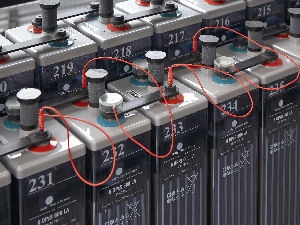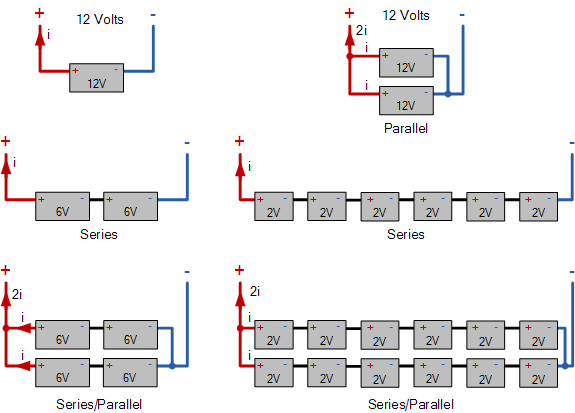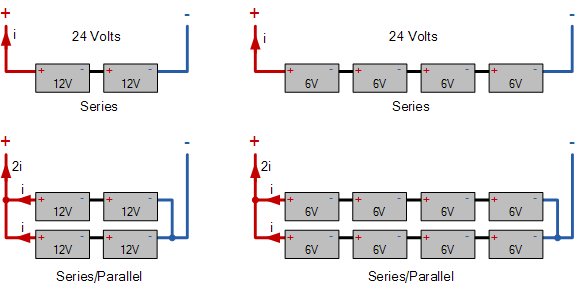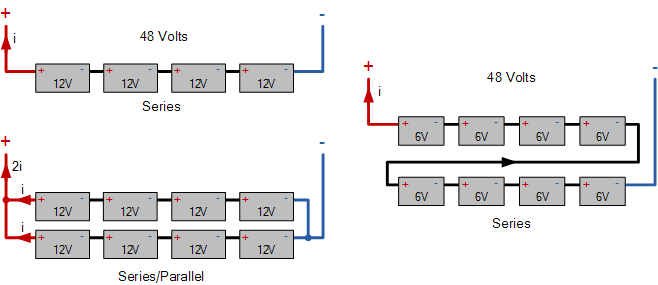
Connecting Batteries Together
Connecting Batteries Together For More Battery Storage
![]() For either off-grid or grid-connected renewable energy systems that use batteries for their energy storage, connecting batteries together to produce larger battery arrays of the desired operating voltage or 24 hour current demand is an important part of any solar power energy storage system.
For either off-grid or grid-connected renewable energy systems that use batteries for their energy storage, connecting batteries together to produce larger battery arrays of the desired operating voltage or 24 hour current demand is an important part of any solar power energy storage system.
Most alternative energy generating systems fall into two main categories, a “grid-connected system”, and an “off-grid system”. Grid-connected systems are so named because they connect directly to the electrical utility grid and if the electrical generating device, solar panels, wind turbines, hydro generator, etc, is producing more electricity than is needed, the excess is fed onto the grid.
But grid-connected systems with battery backup (Hybrid Systems) are also possible. Battery based grid-connected systems require a different type of inverter as well as a battery charge controller to monitor the flow of electricity into and out of the battery bank.
Off-grid or stand alone systems use batteries to store their electrical energy. Off-grid systems are ideal for remote rural areas and applications where the connection to a utility grid is either impractical or unavailable. In these cases, it is more cost effective to install a single stand alone off-grid system than pay the costs of having the local electricity company extend their power lines and cables directly to the home.

All stand-alone and battery backup alternative energy systems whether wind, solar or hydro powered all require some form of battery storage so its important that connecting batteries together is done correctly.
An electrical generator charges the batteries, usually during daylight hours for solar and the batteries supply the power when it is needed, often at night and during cloudy weather, so connecting batteries together to store this free solar energy is and important part of any off-grid renewable system.
The two most common types of rechargeable batteries in use today are lead-acid and alkaline. Lead acid batteries have plates made of lead, mixed with other materials and submerged in a sulphuric acid electrolyte solution. The lead acid battery is an integral part of any off-grid alternative energy electrical system and the fundamental lead-acid technology has not changed since its invention.
Lead-acid batteries are the most common in renewable energy charging systems because their initial cost is lower and because they are readily available nearly everywhere in the world. Deep cycle lead acid batteries are called a secondary battery, as it may be recharged by applying current. A primary battery is one that is not rechargeable. All deep cycle batteries are, therefore, secondary batteries.
Deep cycle batteries are a form of lead-acid battery that is specially designed to provide a steady current over a long period of time. There are many different sizes and designs of deep cycle lead-acid batteries available, all designed to be repeatedly discharged by as much as 80% of their capacity so they are a good choice for off-grid systems. Even though they are designed to withstand deep cycling, these batteries will have a longer life if the cycles are shallower.
Connecting Deep Cycle Batteries
Batteries are generally wired or connected together to produce a specific voltage and amp-hour storage capacity. The batteries of small renewable energy systems, for example, those used to power cabins, RV’s and boats, etc, are typically wired to produce 12-volt electricity.
Off-grid systems used to power homes and businesses, etc, are typically wired to produce 24 or 48 volt DC electricity. This low-voltage DC electricity can also be converted to mains AC electricity by an inverter which boosts the voltage to 120 volts or 240 volts, commonly used to power larger electrical devices.
When more than one deep cycle battery is connected together the resulting battery bank will have either a different voltage or a different amp-hour capacity (or both) when compared to a single battery.
Batteries can be wired or connected together in either series or parallel combinations, or both to increase the voltage or current capacity of the battery bank. Then connecting batteries together allows for more battery storage.
Batteries Connected Together in Series
A battery bank is built up by connecting two or more deep cycle batteries together. Battery banks made from batteries that are connected in series have the same current capacity as the individual batteries, but the voltage is multiplied by the number of batteries in the series string.
In a series connected battery bank the positive terminal of one battery is connected to the negative terminal of the next, and so on. Connecting batteries together in a series combination means a higher voltage for the same current.
Batteries Connected Together in Parallel
Battery banks made from deep cycle batteries that are connected in parallel have the same voltage as the individual batteries, but the current capacity is multiplied by the number of batteries. In a parallel connected battery bank the positive terminal of one battery is connected to the positive terminal of the next with the negative terminal connected to the negative terminal. Connecting batteries together in parallel branches means a higher current for the same terminal voltage.
Series and parallel combinations of batteries within a battery bank increase both the voltage based on the numbers of batteries in the series strings and the current capacity based on the number of series strings connected in parallel. Connecting batteries together in both series and parallel combinations allows for more battery storage at a higher voltage.
Lets look at some of the ways we can connect batteries together to produce higher voltages and current configurations.
Connecting Batteries Together For 12 Volt Wiring

All combinations of series and parallel battery connections will produce an array of 12 volts.
Connecting Batteries Together For 24 Volt Wiring

All combinations of series and parallel battery connections will produce an array of 24 volts.
Connecting Batteries Together For 48 Volt Wiring

Finally, these combinations of series and parallel battery connections will produce an array of 48 volts.
In off-grid stand-alone alternative energy systems, the electrical energy produced by the generating device can not always be used when it is produced. Because the demand for energy does not always coincide with its production, electrical storage batteries are commonly used in many off-grid and grid-tied systems.
The battery bank voltage selection, either 12, 24 or 48 volts often depends on the load voltage requirements of the system, the storage capacity required and the type of batteries available. For larger loads it is sometimes better to connect deep cycle batteries together to produce higher voltages in order to lower the system currents.
For example, a 240 watt DC load operating from a 12 volt battery draws about 20 amps, where as a 240 watt DC load operating from a 48 volt battery only draws 5 amperes, a quarter of the current. This lower system current has many advantages by reducing the size of the cabling, isolation switches and fuses used thereby saving you money.
One final safety point in understanding batteries and connecting together lead-acid cells for greater battery energy storage. Lead acid deep cycle batteries are the most dangerous part of any solar or wind power system. Gloves, eye protection such as goggles and masks as well as old clothes must be worn when handling lead acid batteries and electrolyte as “battery acid” both burns and irritates skin and eyes.
To find out more about “connecting batteries together” and how you can use them as part of a Home Solar system, or to explore the advantages and disadvantages of connecting batteries together for more battery storage and how you can use Deep Cycle Batteries as an alternative to automotive batteries, then why not Click Here and get your copy of one of the top battery builders guide from Amazon today and learn how to build, rebuild and recondition deep cycle lead-acid batteries










Hi, I have a cabin I am wanting to run off grid, I currently use 600KWH per month (high estimate). I have 24 Unigy I 12AVR200RT, 200AH @ 8 Hr rate batteries. What charge controller (s) would I need to run this system and what size inverters would be required?.
Hi,
I have 2 batteries 12v 100A wired in series for 24v system 100A. Can I add 2 more at 12v 200Ah ?
If I wire in parallel 12v 100A with 12v 200A and then both in series, I will have 24V at 300A ? Is it safe for batteries ? They will charge all the same ?
No. If you connect in series you will have 24V 100A. If you connect in parallel you will have 12V 300A
There are 4 batteries – 2x100A and 2x200A.
1x100A and 1x200A connected in parallel is 12v at 300A
1x100A and 1x200A connected in parallel is 12v at 300A
after parallel connection, we connect in series
1x300A and 1x300A connected in series is 24v at 300A
Is not possible ?
If its a 24v system and to guarantee the 300A, put the two 100A batteries together in series, the two 200A batteries together in series and then parallel the two strings.
G’day. Thanks for your site and valuable information. I have 8 x 72ah deep cycle 12v batteries. I want to avoid lining them up in one row of 8. would very much like to line them up in two rows of 4 and wire them to 12volts. I have been trying to find diagrams on the net that might display how to do this, without success. Can you suggest how I could achieve the setup I am asking about? Thanks in advance.
Is it not obvious that if you have 12 volt batteries and you want to “wire them to 12volts.” that you will have 8 batteries in parallel. Your suggestion would give 48 volts (4*12) output.
I think you mean “you will have 8 batteries in SERIES”
Wiring in parallel would increase the voltage
No, wiring 12V batteries in parallel DOES NOT increase the voltage
12v batteries must be parallel connected to produce 12v, but there is still a choice of how to connect them which Stuart may be enquiring about. The batteries can be daisy chained (1 row of 8) Or individually wired to the 12v system, or a combo (2 rows of 4) etc. Electrically similar for sufficiently large wiring. If your wires are on the small side or you frequently remove or add batteries to the system, you might favour induvidual connections. If you use a solid bar across your battery terminals or have very heavy wires and want to minimise wiring and clutter, you might choose daisy-chaining.
QUOTE: (1 row of 8) = 96 volts, not 12 volts
QUOTE: (2 rows of 4) = 48 volts, not 12 volts
The understanding of the very vague question was: QUOTE: ( and wire them to 12volts. ) Stuart wants a 12 volt system.
or am I missing something very obvious here??
Hi,
Help to solve this scenario, i have eight deep cycle batteries with 12V, 200AH capacity, is it possible to get 38,400Wh? after connecting a combination of series and parallel to output 96V and 400AH. What i did is
1). Series connection 12V x 8 batteries = 96V
2). Parallel string connection of 2 string = 200AH x 2 string = 400AH
What you have suggested would potentially give:
1. Series connection – 96V, 200AH = 19,200Wh
2. Parallel connection – 48V, 400AH = 19,200Wh
Therefore, 19,200Wh is the maximum you can obtain with your eight batteries.
Hi there,
I currently have 4 x 6v Rolls/Surette S-550 batteries connected in series to run with my 24v Samlex inverter. Can I add 2 more of the same batteries to my battery bank for increased capacity? If yes, how would I connect the additional batteries (would you have a diagram available for this)? Are there any negative implications as far as charging/discharging the battery bank with such setup?
Thanks for your insight.
Slav
No, adding two more would unbalance the battery bank. You need 4 more to connect in parallel with the existing string.
Thank you!
Hi, I want to connect 8 x 100ah 12v batteries in serie/parallel, to get 48v and a bit more storage in AMP hours. This is possible right?
Yes, two strings of 4 batteries each.
G’day,
I have the chance to buy 20 * 12 volt AGM battery’s at around 100 Ah each for $300. They are second hand batteries from a good mate who is an auto electrician.
My question is can I connect all 20 of them in parallel for a 2000 Ah set up? Are there any problems with this arrangement?
I have three 12 volt solar systems I can use to charge if required, two 40 Ah solar chargers and one 30 Ah solar charger.
Thank you for your time,
Dave.
Automotive batteries are cranking batteries and not deep cycle batteries, so are not recommended for use in solar systems. They will work but not for very long.
I have two 80AH and one 150AH 12V lead acid batteries. Can I connect the 80AH in parallel to make it 12V 160AH and then connect it with the 150AH in serial to make a 24V 150 AH system ? . The batteries are quiet old so there is no worry of shortening of life, But I am worrying about reverse charge or other technical issues. It will be charged by a 1040W, 24V solar panels.
Yes you could do that to make a 24V 160AH system, as 80AH would come from each battery in your parallel combination to combine through the 12V 160AH battery.
Thanks .Actually I tested it yesterday and so far working fine. No heat or fumes or any suspicious activity on any of the batteries.
I have a 48v DC inverter with 4×12v but I have received from a friend 2 more 6v 160Ah each can I add them to my system, or it might increase the voltage and cause damage?
You can not add one or two 6V batteries to a 48V system.
I currently have 4 Trojan T 105 batteries for my 12 volt solar storage system. How can I add 2 Trojan SPRE 12 225 batteries to this system to increase my storage?
T105’s are 6 volt batteries, therefore we assume your 12 volt system is connected as two in series and 2 pairs in parallel. Adding the two SPRE’s will increase your storage but being different capacity batteries you may find that the newer SPRE’s will fully charge at a faster rate than the T105’s. Thus the SPRE’s may become overcharged as your system tries to fully charge the older 105 batteries.
thanks!
may i know how to do the wiring connection to nicd 1.2vdc 4ah to 24vdc 12ah?
I assume you are asking how to connect 1.2V 4Ah nicad batteries to produce 24V 12Ah capacity. Thus 3 strings of 24 nicad batteries, 72 batteries in total.
You did a great job of explaining that I can add two 12v 100Ah batteries as an additional parallel string giving 24v 300Ah. I’ve been thinking about it if it is possible because I am really unsure of it. I’d be interested to learn more of your tutorials, I really find it very useful and informative.
When connecting a second flooded battery in parrallel (12v Group 31 105 AH) to the first, what is the appropriate wire gauge? I will connect so that the load comes off the neg of batt 2 and the pos of batt 1, but can I use 2 gauge for the short interconnects even thought the system has 2/0 for the longer runs to the 15 hp marine diesel starter motor?
I have 2 banks (16 batteries per bank) of 12v 235ah batteries for my 48 volt system.
can I add another bank of 16-12volt 235ah batteries for more storage?
Yes, why not, check your cabling can handle the extra capacity.
Hi. I would like to know, if i have 4×12v 100Ah batteries connected in series/parallel to make it 24V and 200Ah, is it possible to add just 2 more batteries of the same voltage and capacity to make it 24V and 300Ah? Or is it only possible to add 4 more batteries, and not two?
Yes you can add two 12v 100Ah batteries as an additional parallel string giving 24v 300Ah.
Wow cool. How exactly would i wire it up? Do u perhaps please have a diagram for me?
And also, would that be wise decision? Would it damage the batteries in any way? Or is it optimal to rather put in another 4? I would just like to add 2 more, IF the batteries would not be damaged and the charge and discharge rate of all six would remain equal.
At the present I have 8 six volts 428AH connevted at 48VDC which gives me about 2 kilos storage. Is there a way to connect 12 six volts 428 AH in parallel and serial in order to get a higher storage capacity? .
To maintain an array of 48VDC using 6V cells, you would need strings of 8 cells. You could connect the 4 extra cells of your 20 in total in parallel with other 4 cells of one string, but they would be limited by the other series connected four cells. ( 8 in parallel with (4 in series with (4 in parallel with 4)))
Vertreiben sie zwei-achsige sonnennachführsteuerungen auch? vielen dank für eine info.
hochachtungsvoll otmar handler
I have 2x 400/500w 3ph wind generators and wish to connect to a bank of 7 x 110AH deep cycle batteries. I also have a 3000w solid wave inverter but have not purchased a charging controller yet. Help please.
There are 3-phase wind turbine charge controllers available for charging 12/24V battery banks that work using Alternators. Alternatively use a 3-phase AC to DC bridge rectifier and a normal DC input charge controller.
I have 5 12volt, 20 ah batteries connected in series to give me 60 volts. Can I connect 1 12 volt, 20 ah battery in parallel with the 1st. battery to increase the ah?
Yes you can connect another 12V battery in parallel with the first, but the amp-hours will still remain the same at 20Ah. The two parallel batteries will supply 10Ah’s each.
But how it will gives only 10 ah while connecting in parallel.. why it’s not getting summation of two batteries ah..
Because in this particular application, the parallel combination is connected to 4 series batteries which will limit the current flow.
Is there a diagram for connecting 8 6V batteries in series/parallel for 12V out?